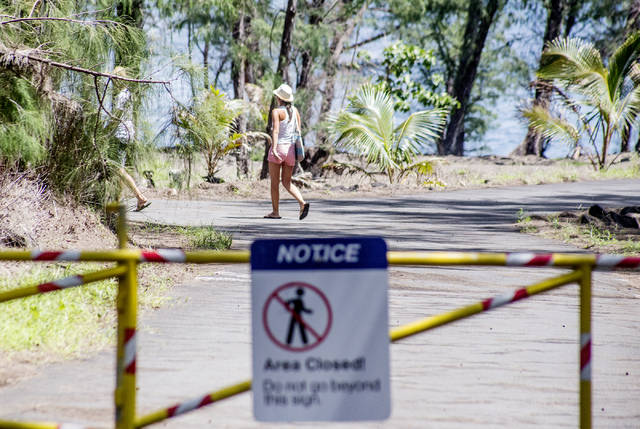Puna residents looking forward to jumping back into the ocean, and even digging their toes into a brand new black sand beach, have reason to rejoice.
Mayor Harry Kim said he asked his staff Wednesday to begin planning for the reopening of Isaac Hale Beach Park, closed for all but one day since May because of the lower Puna eruption.
“I told them the beauty of what is there, and people should enjoy and see the beauty of what was created,” said Kim, referring to comments he made at a county Civil Defense meeting.
He said he couldn’t put a timetable for when the park will be open and accessible again. That requires digging through lava rock covering parts of Highway 137 on the Kalapana side.
There’s also no water or electricity at the park. Kim said generators and potable water might need to be brought in.
Roxcie Waltjen, county Parks and Recreation director, said bathrooms will have to be cleaned “because we’re very sure that people have been crossing over and going down there and using the bathroom facilities down there that did not have any water in them.”
Kim noted restoring access could be temporary if the pause in the Kilauea eruption doesn’t turn out to be permanent. But he said he understands the importance of the park to the district, which hosts the only boat ramp and best ocean access in that part of the island.
“I really felt this must be shared, this must be felt by people,” he said. “Because beyond destruction, there is this.”
County staff faced questions from the public Wednesday evening at a community meeting in Pahoa about when the park will reopen.
Steve Hirakami, director of the Hawaii Academy of Arts and Science charter school, noted the importance of the Pohoiki park to the district’s keiki.
“We have a very important resource at Pohoiki,” he said. “This is where the community gathered every weekend.”
Hirakami said the “children — and even the big children — don’t want to hear no can. They want to hear how can.”
The new beach was formed from lava pouring into the ocean. Molten rock also edged its way into the park, but spared the state-owned boat ramp, now blocked by the beach.
Dan Dennison, a state Department of Land and Natural Resources spokesman, said in an email that staff will take a look at the boat ramp next week, but have made no decisions about it being reused. Though blocked, it was never closed.
In addition to destroying more than 700 homes, the eruption also covered Ahalanui warm pond and a nearby charter school.
MacKenzie State Recreation Area, another coastline park that was spared, remains closed.
Dennison noted that he can’t confirm the reopening of MacKenzie, but added that in regard to that park and Pohoiki, “we should have more information in the next 24 hours.”
The county recently removed a few checkpoints intended to keep people away from the eruption area, though people can still be fined for getting within 50 yards of the flow field and other volcanic features, said Talmadge Magno, county Civil Defense administrator. Waivers are provided on a case-by-case basis to property owners who contact Civil Defense about their need for access.
As for the mandatory evacuation area in Leilani Estates, he said he is looking to remove that soon, but couldn’t say when.
A Hawaii Electric Light Co. representatives said at the Wednesday meeting that HELCO also is trying to restore power to that area.
It’s been about a month since lava was flowing out of fissure 8, which still hosts a lava pond and appears to be building a new lava cone within the pond.
Frank Trusdell, a geologist with the Hawaiian Volcano Observatory, said that shows the eruption isn’t dead yet.
But what this could lead to remains to be seen. Options include a restart of lava flows out of the fissures, relocation of the eruption to Pu‘u ‘O‘o, or a return to inflation at the summit as magma refills the reservoir.
Trusdell said there also is slight inflation detected at a sensor between Pu‘u ‘O‘o and fissure 8, potentially signaling the entrance of more magma. He said it’s small enough to possibly be “noise” but will continue to be closely monitored.
Email Tom Callis at tcallis@hawaiitribune-herald.com.
Email John Burnett at jburnett@hawaiitribune-herald.com.


